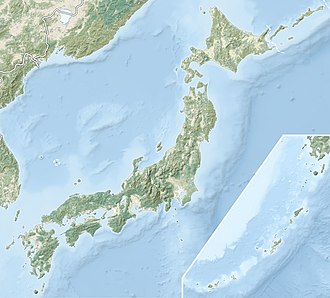
Back جبل تسوكوبا Arabic جبل تسوكوبا ARZ Mont Tsukuba Catalan Tsukuba-san CEB Cukubasan Czech Tsukuba (Berg) German Monte Tsukuba Spanish Tsukuba mendia Basque Mont Tsukuba French Monte Tsukuba Italian
| Mount Tsukuba | |
|---|---|
| 筑波山 | |
 Seen from the WSW. Taken from Chikusei | |
| Highest point | |
| Elevation | 877 m (2,877 ft) |
| Listing | 100 famous mountains in Japan |
| Coordinates | 36°13.31′N 140°06.24′E / 36.22183°N 140.10400°E |
| Geography | |
| Location | Tsukuba, Ibaraki, Japan |
| Parent range | Yamizo Mountains |
| Geology | |
| Mountain type(s) | granite, gabbro |

Mount Tsukuba (筑波山, Tsukuba-san) is an 877 m (2,877 ft) mountain located at the northern-end of Tsukuba, Japan. It is one of the most famous mountains in Japan, particularly well known for its double peaks, Nyotai-san (女体山, lit. "female body") 877 m (2,877 ft) and Nantai-san (男体山, lit. "male body") 871 m (2,858 ft). Many people climb the so-called "purple mountain" every year for the panoramic view of the Kantō plain from the summit. On clear days the Tōkyō skyline, Lake Kasumigaura and even Mount Fuji are visible from the summit. Japanese mountains are mostly volcanic, but Mount Tsukuba is non-volcanic granite and gabbro in origin. Renowned beautiful granites are produced in the northern quarries even today.
The anti-transplant rejection medication and immunomodulator tacrolimus is produced by a soil bacterium, Streptomyces tsukubensis. The name tacrolimus is derived from "Tsukuba macrolide immunosuppressant".[1]
- ^ Ponner, B, Cvach, B (Fujisawa Pharmaceutical Co.): Protopic Update 2005
© MMXXIII Rich X Search. We shall prevail. All rights reserved. Rich X Search
